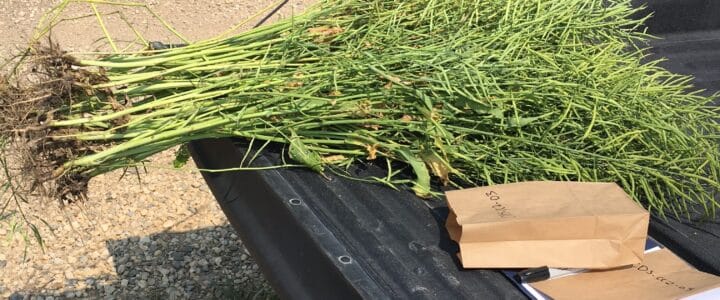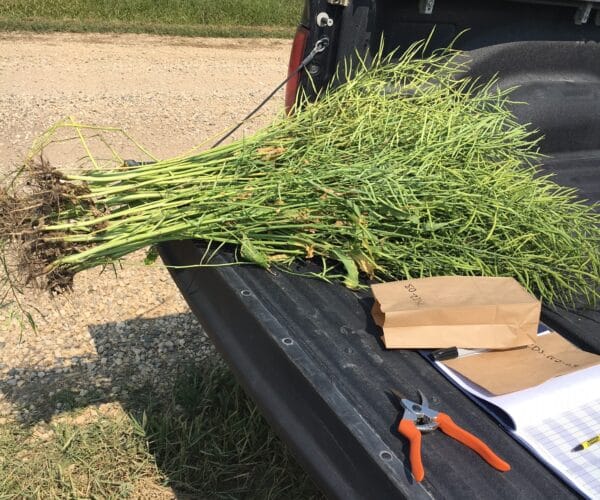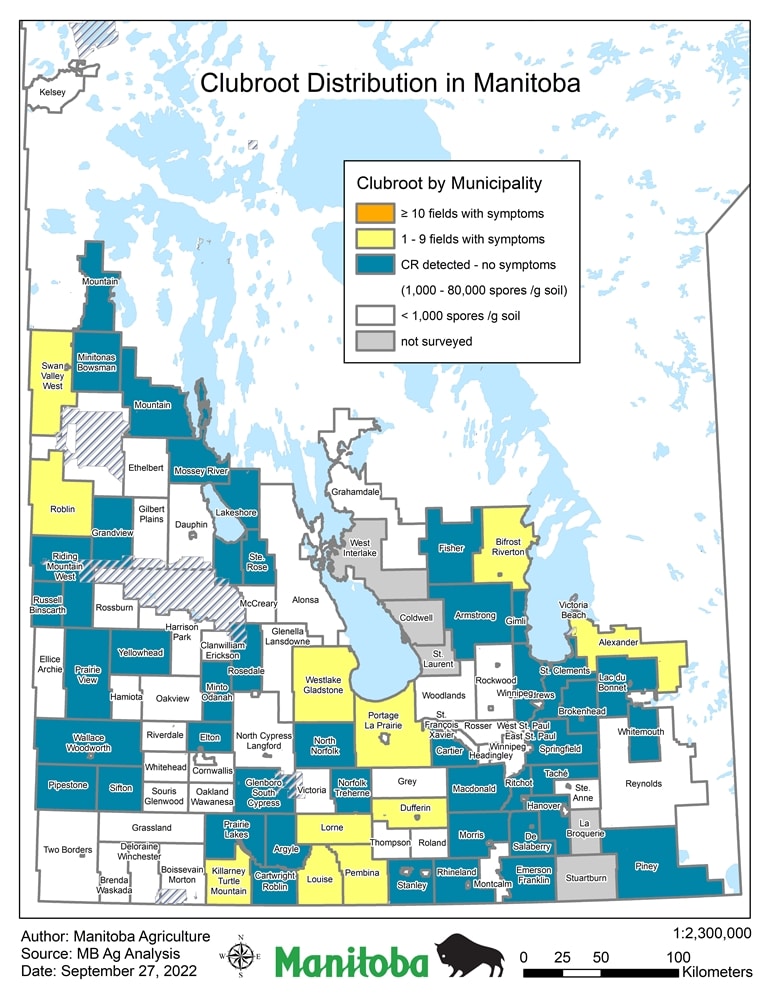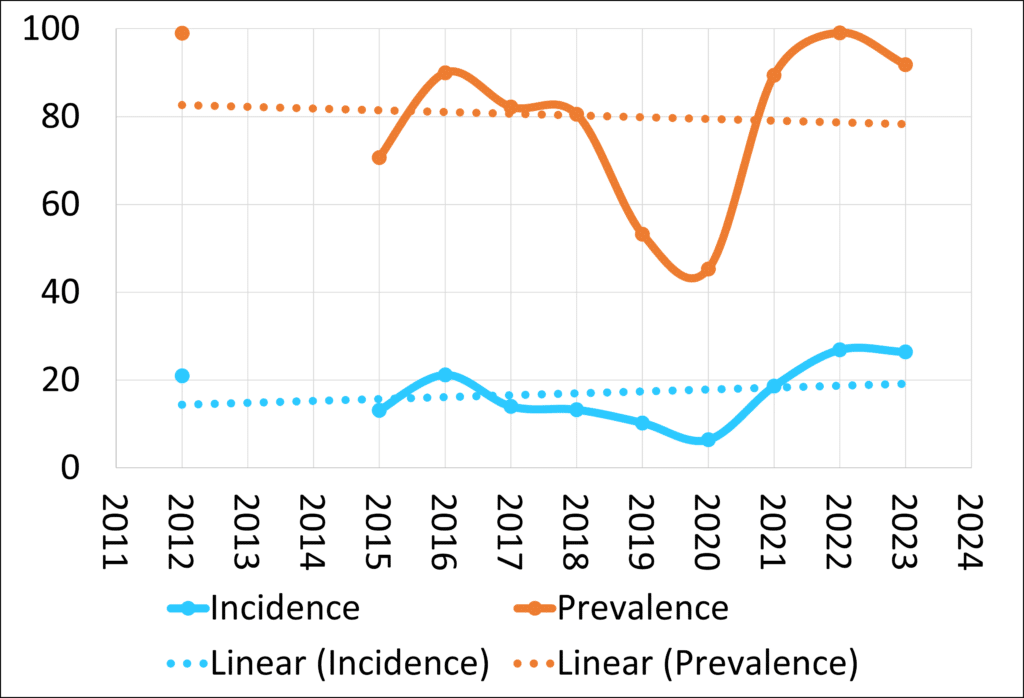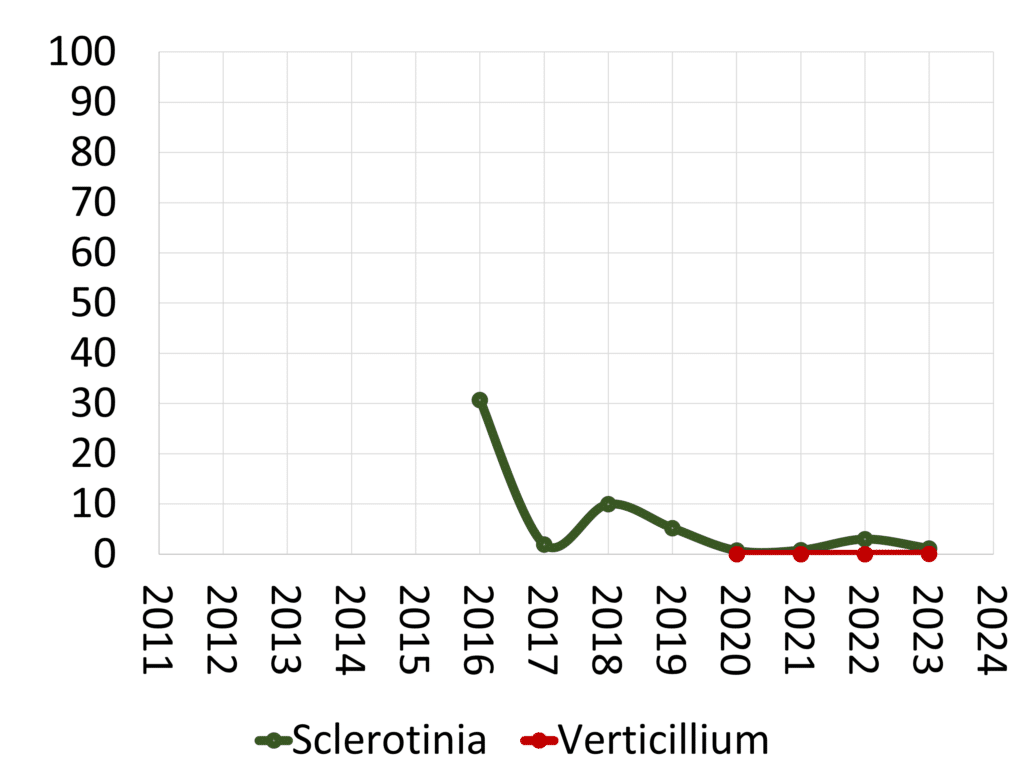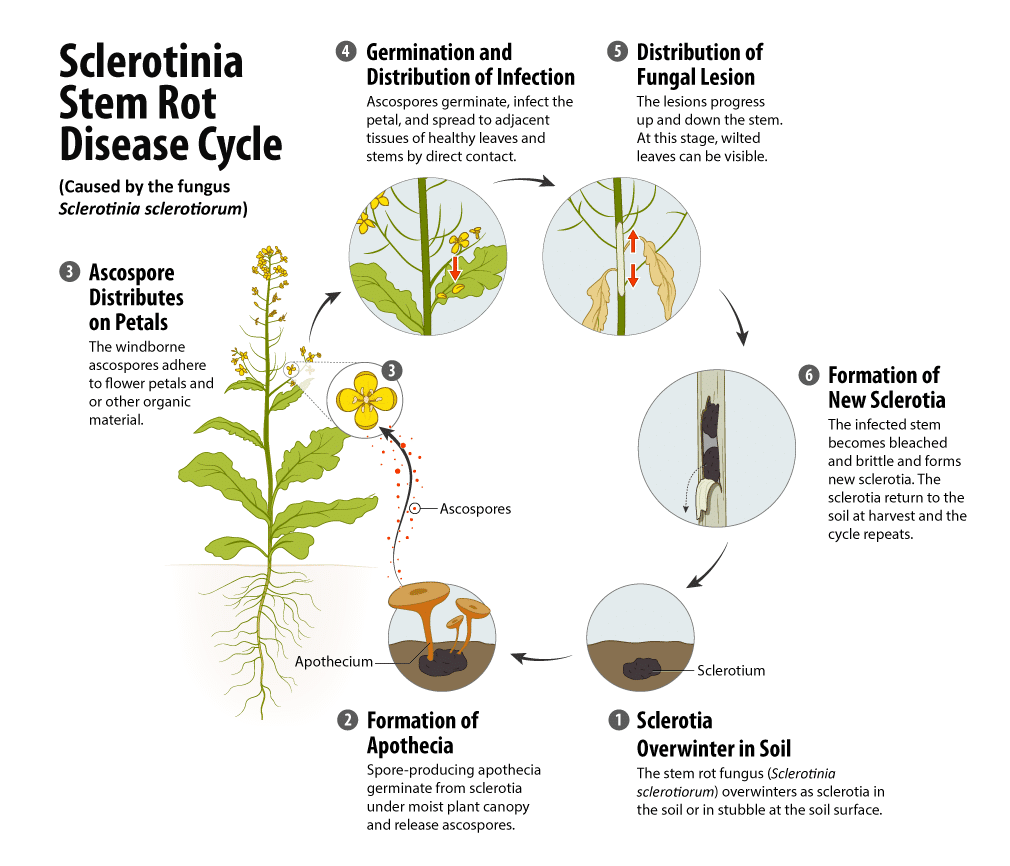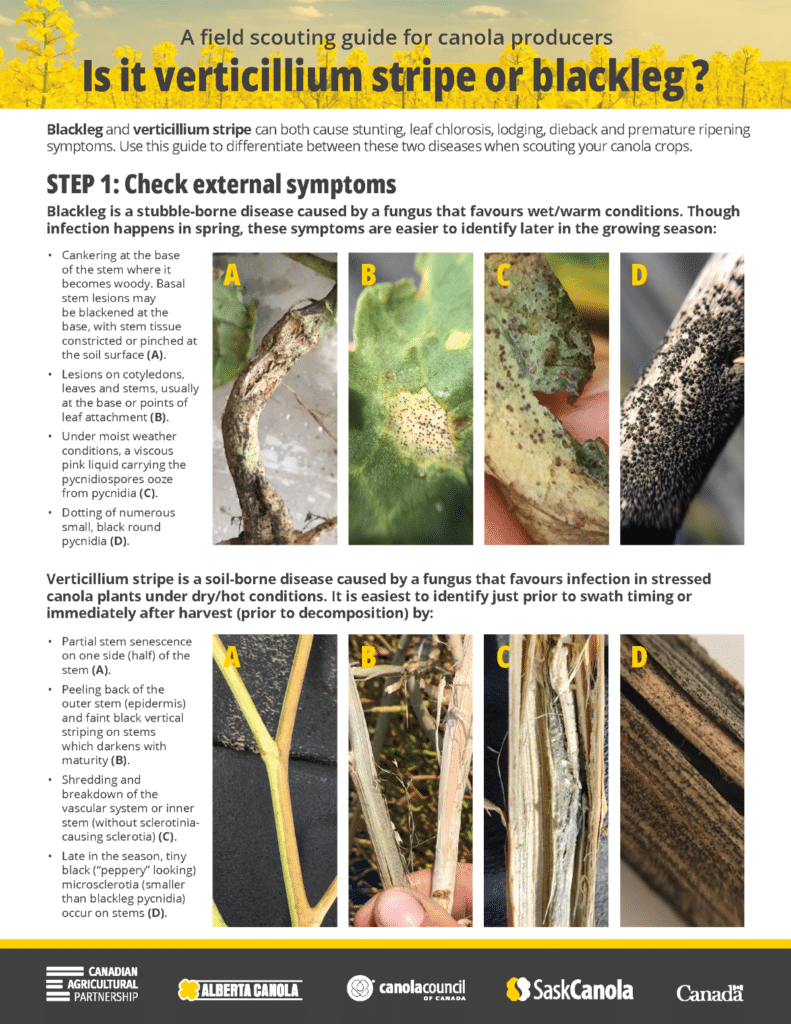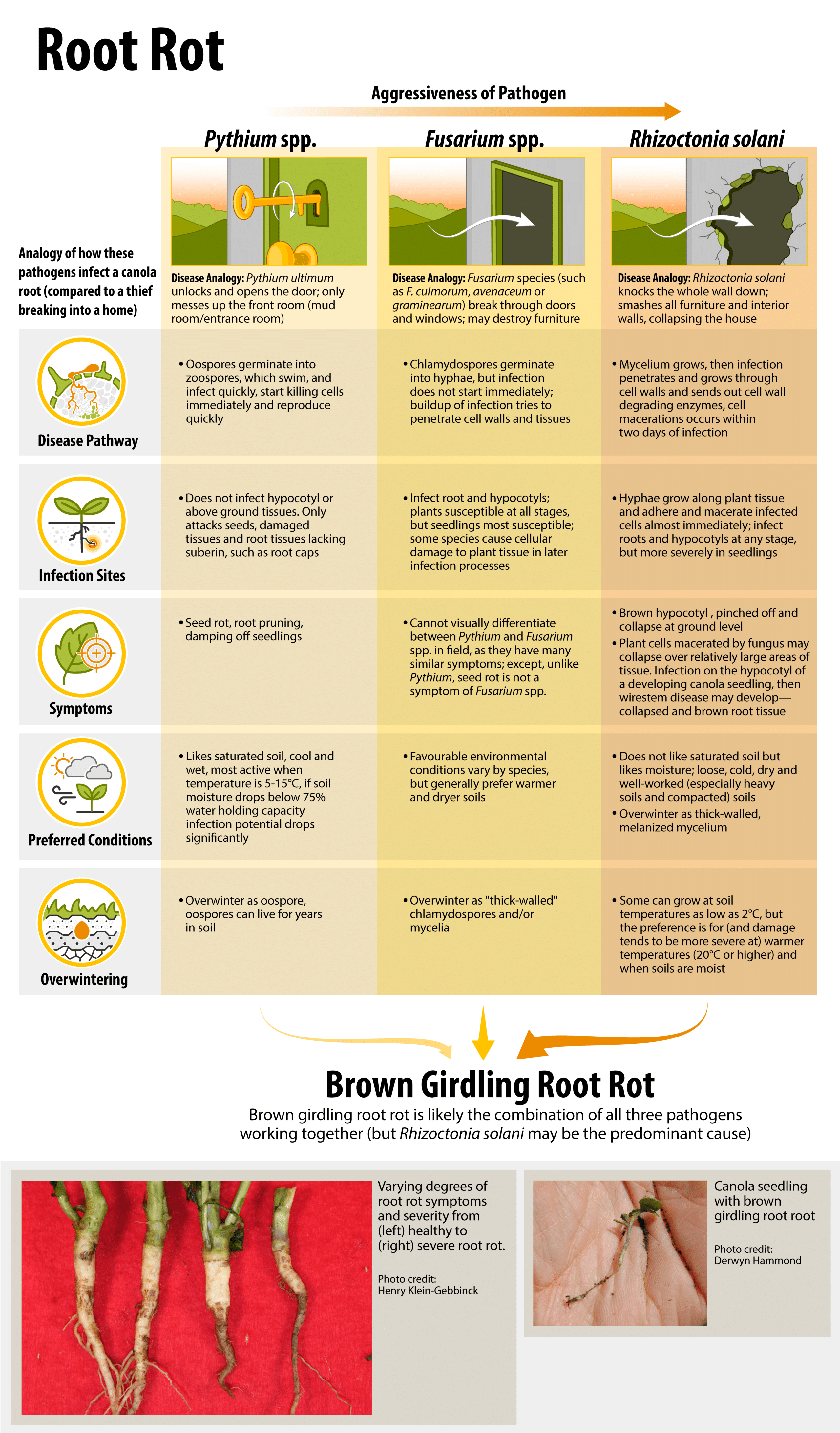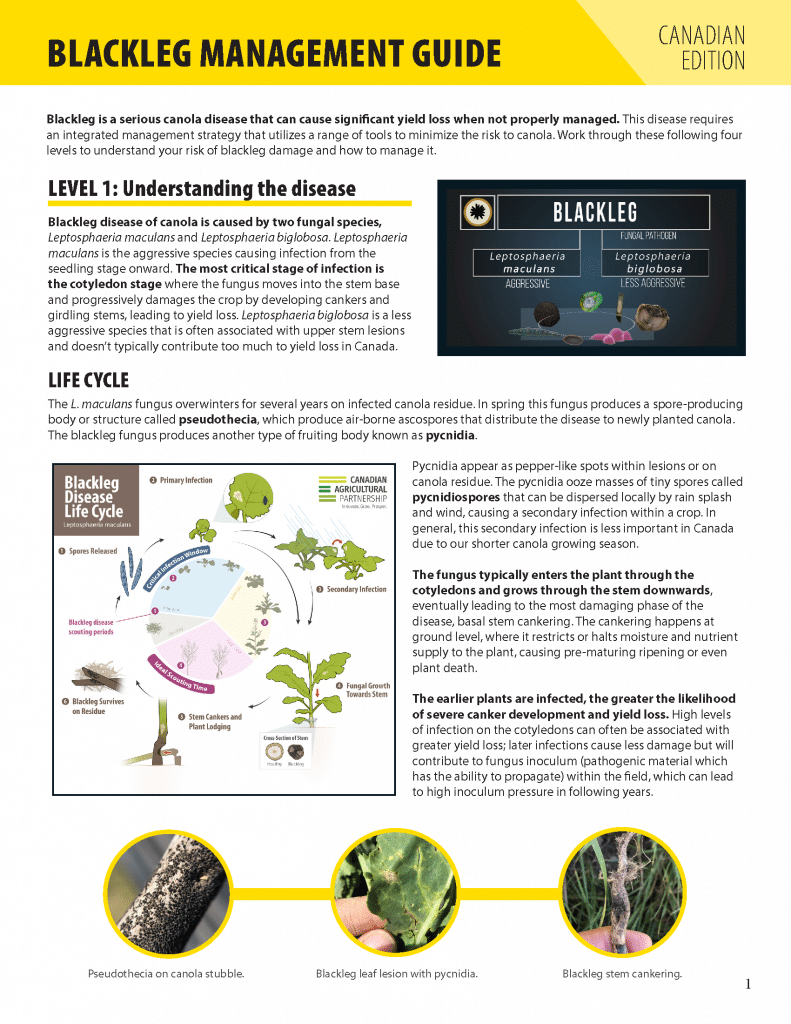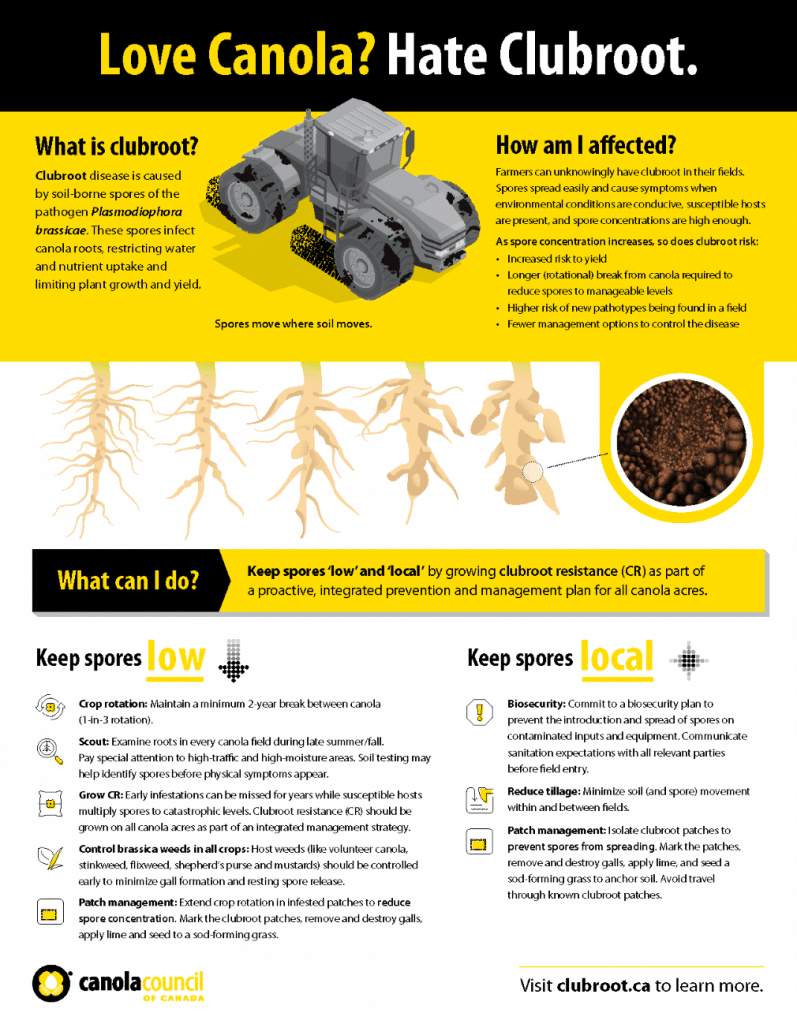There are many excellent meetings and conferences throughout the winter which provide useful updates on the crop disease situation across the Prairies and in specific provinces. Drawing from all of these events, related reports and the provincial crop pathology experts, this blog summarizes the diseases pressures that impacted canola in 2023 and how this can inform what can be done in 2024 to support canola production.
To ensure the disease survey results are interpreted as accurately as possible, keep in mind:
- Prevalence is the % of fields surveyed that have infection in them.
- Incidence is the % of plants surveyed within a field that have disease symptoms.
- Severity is the degree of infection in a plant, often rated with a scale (ex. 0-5 scale for blackleg).
- For any canola disease to be present, the disease-causing pathogen must have been present (ex. Sclerotinia sclerotiorum), the host plant (ex. canola) must have been present and the environment must have been conducive to the disease (ex. warm and humid). These three components are often referred to as the disease triangle.
- Proper scouting methods (including the random selection of at least 100 plants from a “W” pattern in a field) are essential to the collection of good quality data.
The complete plant disease situation from 2023, will be posted in the Canadian Journal of Plant Pathology once finalized.
Apply this research on your farm
- Assess disease risks using these maps and data along with your notes on your 2023 fields (and plan for record-keeping in 2024).
- Use CCC resources to better understand disease cycles and which strategies are effective to address them.
- Make a disease management plan with your agronomist which includes scouting and reference guides.
- Sign up to support provincial disease survey efforts.
- Subscribe to Canola Watch and Prairie Crop Disease Monitoring Network (PCDMN) for updates this growing season.
Manitoba survey results
A total of 129 canola crops were surveyed by Manitoba Agriculture and Agriculture and Agri-Food Canada Brandon staff between August 2-30, 2023 in the major canola production regions of Manitoba. Regions included Southwest (46), Central (40), Northwest (29), Eastern/ Interlake (14). The majority of the crops were surveyed before while canola is ripening, before swathing. To understand the environmental conditions throughout the growing season, see the Manitoba seasonal summary.
A summary of the disease survey dataset is provided in the table and a comparison of canola disease prevalence over the past five years is provided in the graph. Regional disease survey results and detailed results from the last five years are provided in the Manitoba Canola Disease Survey for 2023 report.
Further details on this survey (such as foot rot was not observed in the survey) are available in the WFPM 2023 oilseed disease report. This report also explains that there was one new symptomatic case of clubroot in the 129 canola fields surveyed, which does not require changes to the clubroot distribution map, so the previous clubroot distribution map for Manitoba is still applicable. In addition, three positive cases were documented outside of the survey from submitted soil samples. Soil samples from 40 additional fields have been collected and are currently being processed for clubroot DNA.
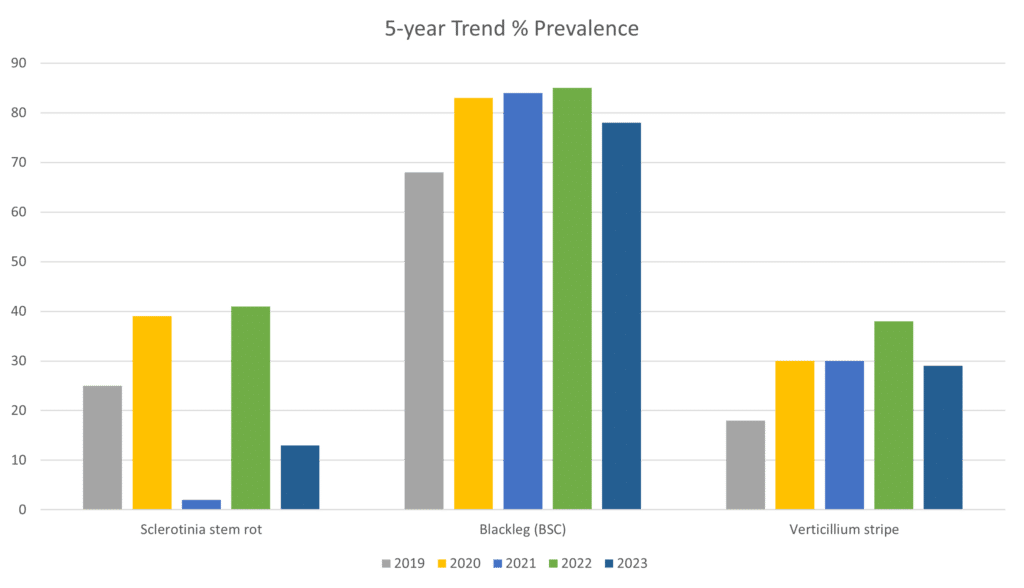
| Canola Disease | Prevalence | Incidence* | Severity |
| Alternaria pod spot | 9% | – | 0.1 |
| Aster yellows | 21% | – | – |
| Blackleg (basal) | 78% | 10% | 1.1 |
| Blackleg (stem) | 29% | 0.9% | – |
| Clubroot | <1% | – | – |
| Sclerotinia stem rot | 13% | 5% | 0.2 |
| Verticillium stripe | 29% | 3% | – |
Actions to take in Manitoba in 2024
- Learn from the Canola Council of Canada’s disease cycle infographics and utilize suggestions from disease management guides.
- Get involved. Contact David Kaminski, Field Crop Pathologist with Manitoba Agriculture out of Carman, Manitoba if you are willing to participate in the 2024 survey (again or for the first time) or have questions about the disease survey process or results.
- Submit free canola samples to the PSI lab through the #GetTested program for clubroot, blackleg presence and race identification and verticillium stripe testing, if you are a member of the Manitoba Canola Growers qualify. Additional testing offered at a fee include glyphosate resistance kochia and Amarnath species identification.
Saskatchewan disease survey
The results of the 2023 Saskatchewan canola disease survey, which included 218 surveyed fields located across the major canola growing regions of Saskatchewan. Verticillium stripe was confirmed (by PCR) in 23 fields. No new visible clubroot symptoms were reported by the Saskatchewan clubroot monitoring program in 2023.
As noted in the WFPM 2023 oilseed disease report, symptoms of powdery mildew were observed in 13 of the surveyed fields. Symptoms suggesting downy mildew, white rust, and bacterial pod spot were not found in any of the surveyed fields assessed. For regional disease survey results, see the WFPM 2023 oilseed disease report.
In addition to the regular disease survey, the Saskatchewan Ministry of Agriculture initiated a verticillium-specific survey in 2023, targeting 100 fields across Saskatchewan to assess the prevalence and incidence of the disease and help evaluate the risk this disease poses to canola production in Saskatchewan. Initial observations suggested that verticillium stripe is no longer a rare disease in Saskatchewan, as depicted in the Ministry of Agriculture’s 2023 Verticillium Stripe Distribution in Saskatchewan map.
| Canola Disease | Prevalence | Incidence* | Severity* |
| Alternaria pod spot | 48% | – | 0.1 |
| Aster yellows | 65% | 2% | – |
| Blackleg (basal) | 72% | 12% | 0.2 |
| Blackleg (stem) | 32% | 3% | – |
| Foot rot | 3% | – | – |
| Sclerotinia stem rot | 30% | 4% | 0.1 |
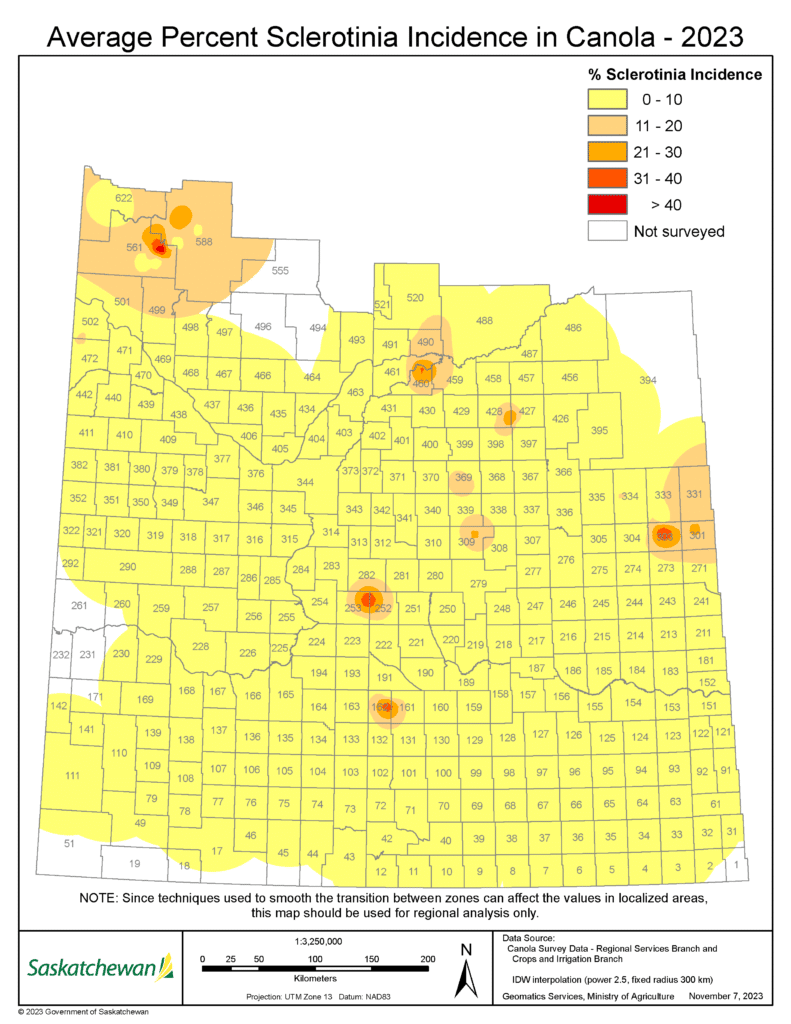
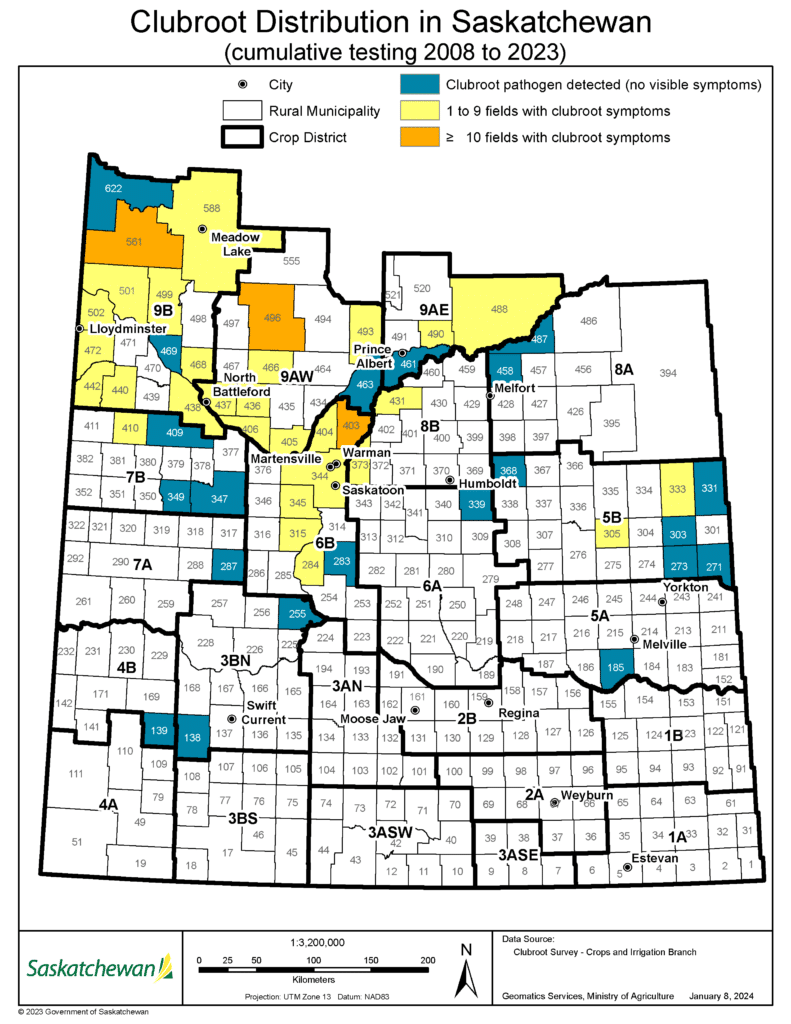
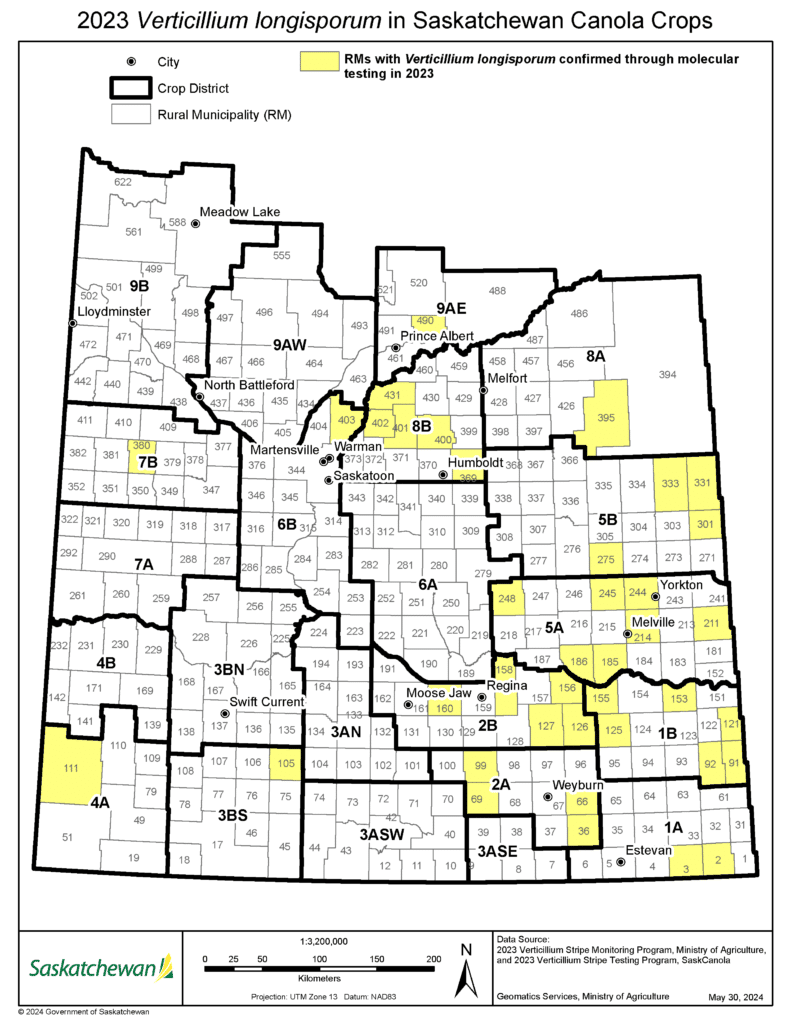
Actions to take in Saskatchewan in 2024
- Learn from the Canola Council of Canada’s disease cycle infographics, monitor fields and utilize suggestions from disease management guides, including ensuring canola varieties selected are resistant to blackleg and clubroot.
- Take advantage of the disease monitoring program offered by SaskCanola in partnership with the Saskatchewan Ministry of Agriculture, for verticillium stipe, clubroot and blackleg. The first 200 registered canola growers are eligible for a free blackleg and verticillium stripe test, by just providing one sample.
- To support the crop disease surveying efforts fill out the Pest Monitoring Sign-up Form and/or become a Volunteer Crop Reporter for the coming growing season.
Alberta
Two disease survey efforts take place in Alberta, which are provided in the WFPM 2023 oilseed disease report. The Alberta survey took place between August 3 and October 6, 2023 and included 380 canola fields. The north-central Alberta survey included 50 canola fields. Preliminary results from these surveys are presented in the table. As with all other reports, the complete plant disease situation from 2023, will be posted in the Canadian Journal of Plant Pathology once finalized.
To recall the environmental conditions throughout the growing season, check out the Alberta seasonal summary report.
| Alberta survey | Alberta north-central survey | |||||
| Canola disease | No. of fields rated | Prevalence | Incidence | Severity | No. of fields rated | Incidence |
| Blackleg | 353 | 92% | 26.4% | 0.5 | 50 | 10% |
| Clubroot | 611 | 6.2%* | 0.6% | 0.5 | 50 | 3.5% |
| Root rot | – | no data | no data | no data | 50 | 11.2% |
| Sclerotinia stem rot | 346 | 21.4% | 1.2% | no data | 50 | 11.0% |
| Verticillium stripe | 356 | 18.2% | 0.9% | no data | 50 | no data |
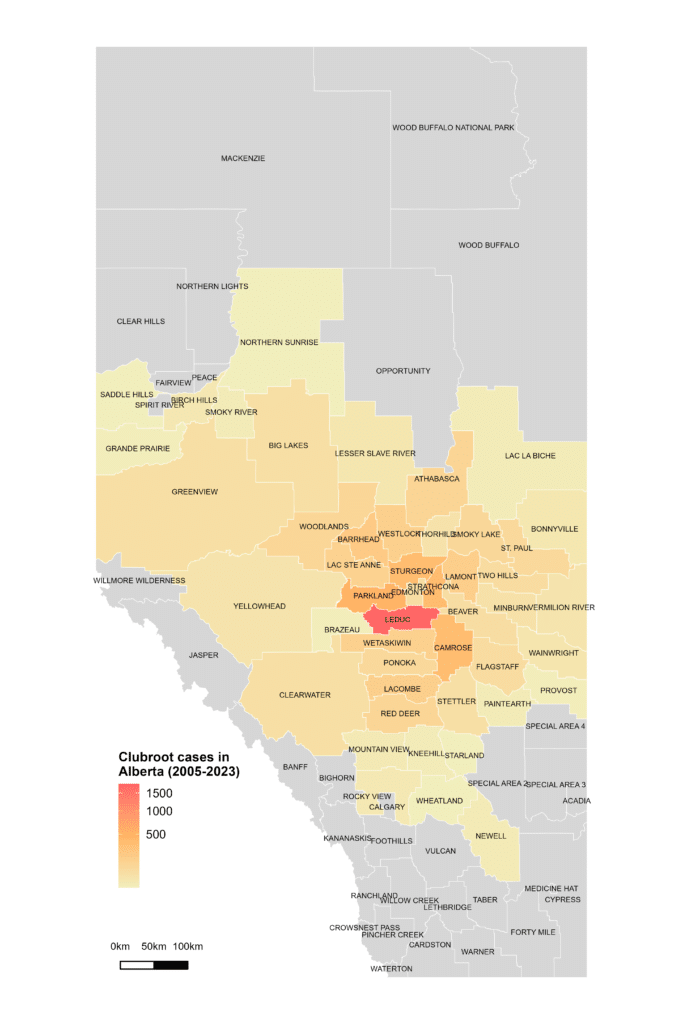
For more updates on the canola disease status in Alberta:
- Watch Michael Harding’s ‘Blackleg hot spots and risk prediction in Alberta‘ Canola Week 2023 presentation.
- Check out Michael Harding’s ‘Clubroot monitoring and management‘ slides from 2024 Agronomy Update.
- Review Kelly Turkington’s ‘Disease Update 2023 Overview & 2024 Outlook‘ slides from 2024 Agronomy Update.
Actions to take in Alberta in 2024
- Learn from the Canola Council of Canada’s disease cycle infographics, monitor fields and utilize suggestions from disease management guides, including ensuring canola varieties selected are resistant to blackleg and clubroot.
- For additional sclerotinia stem rot information, visit the Prairie Crop Disease Monitoring Network Blog for stem rot and risk updates based on soil moisture.
- Utilize 20/20 Seed Labs or other labs in Alberta to find out what is your field.
Helpful canola resources to use in 2024
To help understand and differentiate between common canola diseases and reminders to minimize disease impact and maximize crop potential, check out these top three Canola Council of Canada’s disease cycles, videos, online tools and disease management guides to help you manage canola diseases this year.
- Blackleg: Watch the Blackleg in Canola video, follow the Blackleg Management Guide and use the Blackleg yield loss Calculator.
- Clubroot: Watch the Clubroot of Canola video, use the Clubroot Management Guide and check out Clubroot.ca
- Sclerotinia stem rot: Check out the sclerotinia stem rot disease cycle, watch this sclerotinia fungicide timing video and the sclerotinia spray decision video.
- Verticillium stripe: Watch this verticillium stripe in canola video, review the disease cycle infographic and use the Verticillium stripe field scouting guide
- Other canola diseases: Differentiate between root rot diseases with this infographic, learn about aster yellows with this infographic and bring along the Canola Disease Scouting Guide.
- Remember to always Keep It Clean: ensure you are following blackleg management recommendations and make use of the Spray to Swath calculator for all fungicides.
- Record-keeping: Document in-season decisions with the CCC’s phenology tracking sheet to get more value from post-season reviews and assessments.
Published March 28, 2024 (Updated July 3, 2024)


